BO1BLAW204 Business Law: Analyzing Contract and Negligence Issues
VerifiedAdded on 2023/06/11
|10
|2455
|307
Case Study
AI Summary
This assignment presents two distinct legal scenarios. The first examines a contract dispute between Jessica and Angela, focusing on whether Jessica misrepresented the profitability of her restaurant, potentially allowing Angela to terminate the contract. It applies contract law principles related to misrepresentation, including the elements of a false statement of fact, reliance, and intent. The analysis concludes that Angela likely has grounds to rescind the contract and claim damages due to Jessica's misrepresentation. The second scenario involves Sandra and Andy, who suffered harm due to a contaminated cola purchased from a local store. This part analyzes negligence principles, specifically duty of care, breach of duty, and causation, to determine if Acme, the manufacturer, can be held liable for Andy's illness. The analysis concludes that while the retailer was initially liable, Acme may be responsible for compensating Andy due to the retailer's bankruptcy, highlighting the interconnected liabilities in product-related negligence cases. Desklib offers more solved assignments and past papers for students.
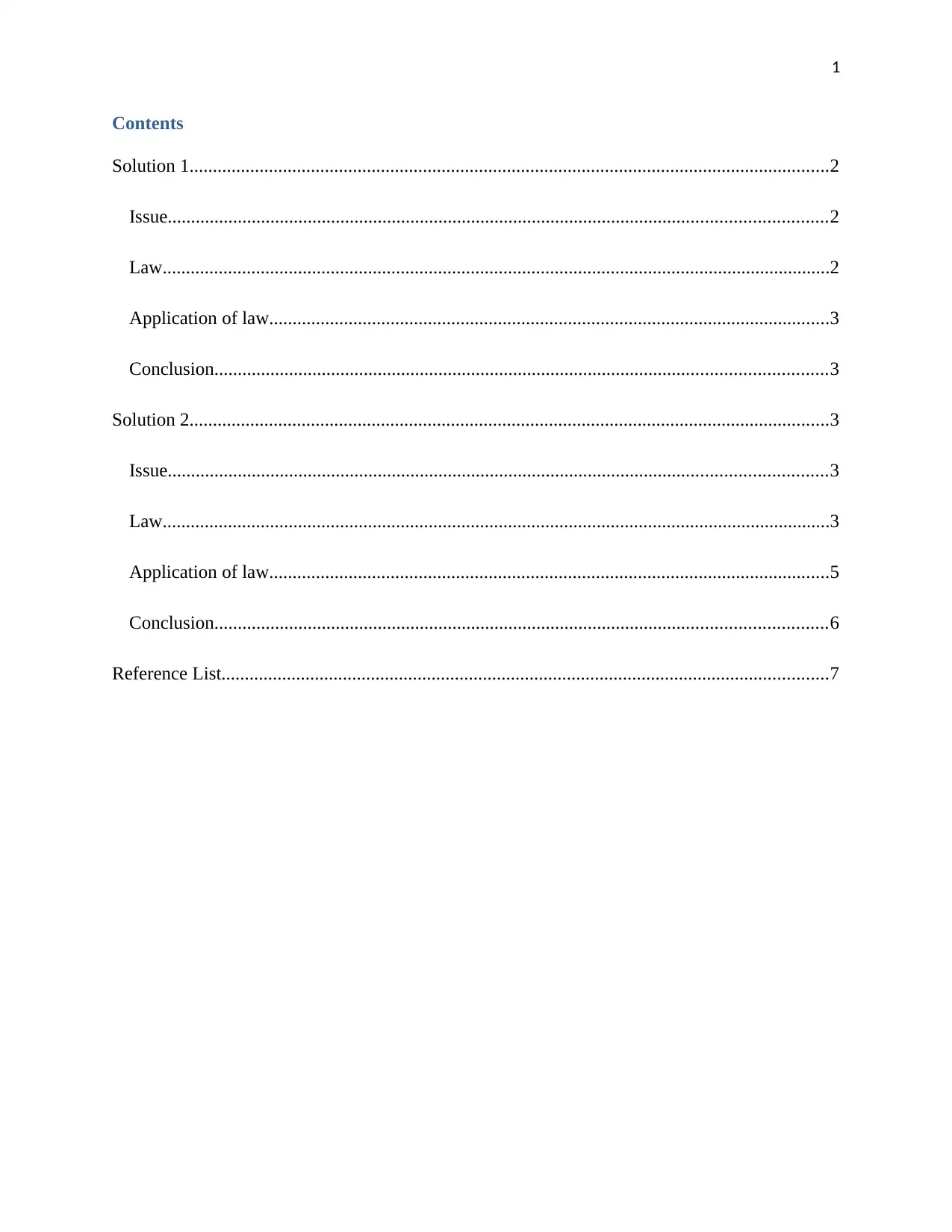
1
Contents
Solution 1.........................................................................................................................................2
Issue.............................................................................................................................................2
Law...............................................................................................................................................2
Application of law........................................................................................................................3
Conclusion...................................................................................................................................3
Solution 2.........................................................................................................................................3
Issue.............................................................................................................................................3
Law...............................................................................................................................................3
Application of law........................................................................................................................5
Conclusion...................................................................................................................................6
Reference List..................................................................................................................................7
Contents
Solution 1.........................................................................................................................................2
Issue.............................................................................................................................................2
Law...............................................................................................................................................2
Application of law........................................................................................................................3
Conclusion...................................................................................................................................3
Solution 2.........................................................................................................................................3
Issue.............................................................................................................................................3
Law...............................................................................................................................................3
Application of law........................................................................................................................5
Conclusion...................................................................................................................................6
Reference List..................................................................................................................................7
Paraphrase This Document
Need a fresh take? Get an instant paraphrase of this document with our AI Paraphraser
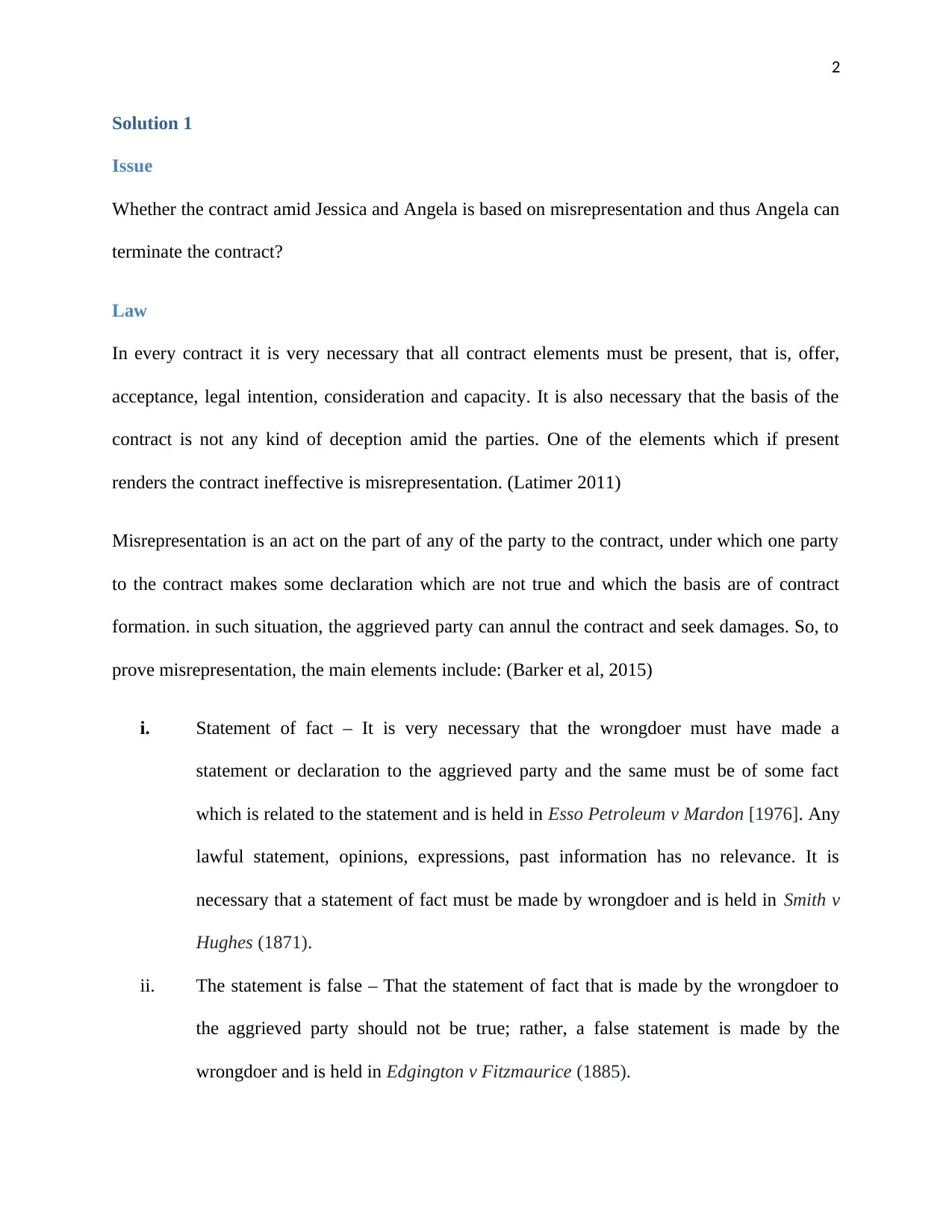
2
Solution 1
Issue
Whether the contract amid Jessica and Angela is based on misrepresentation and thus Angela can
terminate the contract?
Law
In every contract it is very necessary that all contract elements must be present, that is, offer,
acceptance, legal intention, consideration and capacity. It is also necessary that the basis of the
contract is not any kind of deception amid the parties. One of the elements which if present
renders the contract ineffective is misrepresentation. (Latimer 2011)
Misrepresentation is an act on the part of any of the party to the contract, under which one party
to the contract makes some declaration which are not true and which the basis are of contract
formation. in such situation, the aggrieved party can annul the contract and seek damages. So, to
prove misrepresentation, the main elements include: (Barker et al, 2015)
i. Statement of fact – It is very necessary that the wrongdoer must have made a
statement or declaration to the aggrieved party and the same must be of some fact
which is related to the statement and is held in Esso Petroleum v Mardon [1976]. Any
lawful statement, opinions, expressions, past information has no relevance. It is
necessary that a statement of fact must be made by wrongdoer and is held in Smith v
Hughes (1871).
ii. The statement is false – That the statement of fact that is made by the wrongdoer to
the aggrieved party should not be true; rather, a false statement is made by the
wrongdoer and is held in Edgington v Fitzmaurice (1885).
Solution 1
Issue
Whether the contract amid Jessica and Angela is based on misrepresentation and thus Angela can
terminate the contract?
Law
In every contract it is very necessary that all contract elements must be present, that is, offer,
acceptance, legal intention, consideration and capacity. It is also necessary that the basis of the
contract is not any kind of deception amid the parties. One of the elements which if present
renders the contract ineffective is misrepresentation. (Latimer 2011)
Misrepresentation is an act on the part of any of the party to the contract, under which one party
to the contract makes some declaration which are not true and which the basis are of contract
formation. in such situation, the aggrieved party can annul the contract and seek damages. So, to
prove misrepresentation, the main elements include: (Barker et al, 2015)
i. Statement of fact – It is very necessary that the wrongdoer must have made a
statement or declaration to the aggrieved party and the same must be of some fact
which is related to the statement and is held in Esso Petroleum v Mardon [1976]. Any
lawful statement, opinions, expressions, past information has no relevance. It is
necessary that a statement of fact must be made by wrongdoer and is held in Smith v
Hughes (1871).
ii. The statement is false – That the statement of fact that is made by the wrongdoer to
the aggrieved party should not be true; rather, a false statement is made by the
wrongdoer and is held in Edgington v Fitzmaurice (1885).
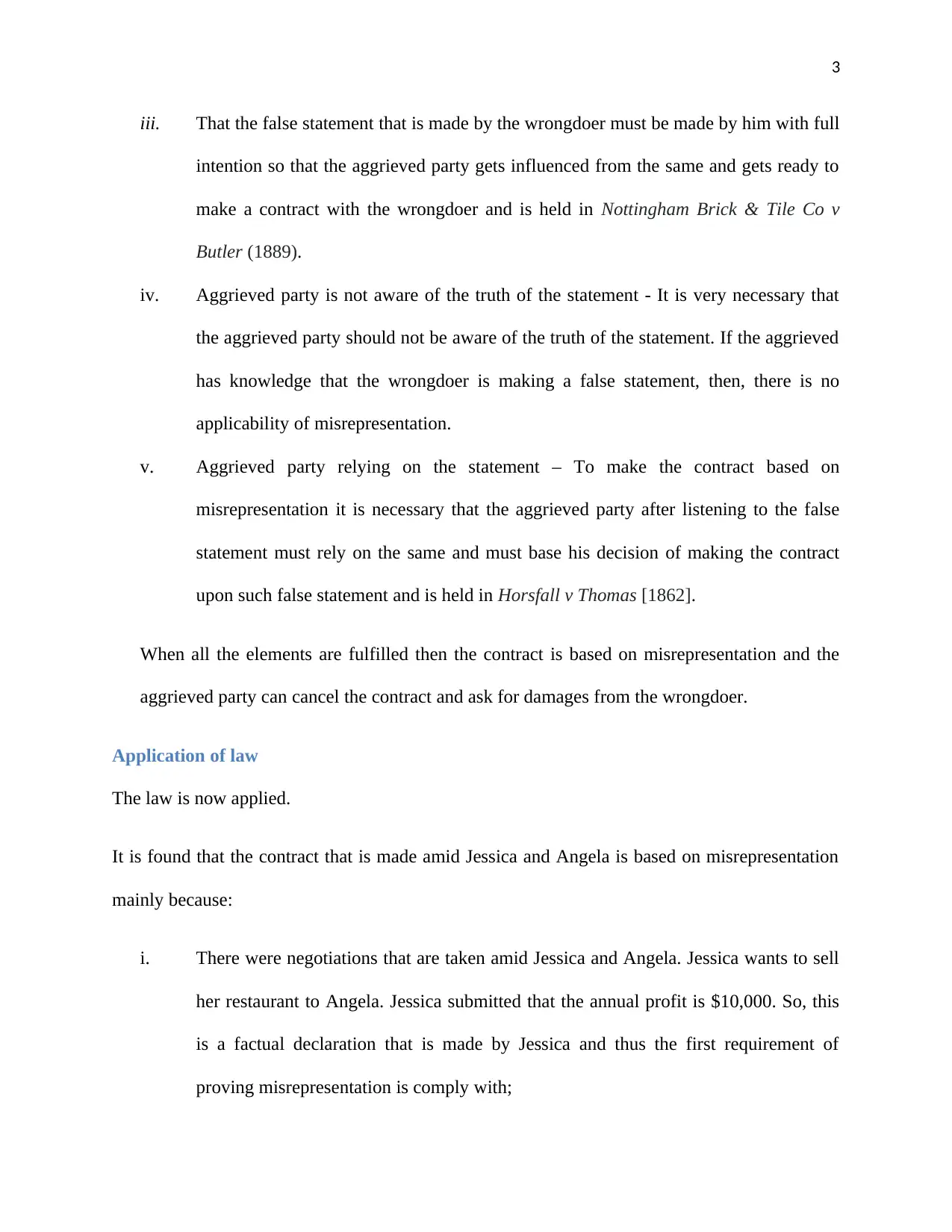
3
iii. That the false statement that is made by the wrongdoer must be made by him with full
intention so that the aggrieved party gets influenced from the same and gets ready to
make a contract with the wrongdoer and is held in Nottingham Brick & Tile Co v
Butler (1889).
iv. Aggrieved party is not aware of the truth of the statement - It is very necessary that
the aggrieved party should not be aware of the truth of the statement. If the aggrieved
has knowledge that the wrongdoer is making a false statement, then, there is no
applicability of misrepresentation.
v. Aggrieved party relying on the statement – To make the contract based on
misrepresentation it is necessary that the aggrieved party after listening to the false
statement must rely on the same and must base his decision of making the contract
upon such false statement and is held in Horsfall v Thomas [1862].
When all the elements are fulfilled then the contract is based on misrepresentation and the
aggrieved party can cancel the contract and ask for damages from the wrongdoer.
Application of law
The law is now applied.
It is found that the contract that is made amid Jessica and Angela is based on misrepresentation
mainly because:
i. There were negotiations that are taken amid Jessica and Angela. Jessica wants to sell
her restaurant to Angela. Jessica submitted that the annual profit is $10,000. So, this
is a factual declaration that is made by Jessica and thus the first requirement of
proving misrepresentation is comply with;
iii. That the false statement that is made by the wrongdoer must be made by him with full
intention so that the aggrieved party gets influenced from the same and gets ready to
make a contract with the wrongdoer and is held in Nottingham Brick & Tile Co v
Butler (1889).
iv. Aggrieved party is not aware of the truth of the statement - It is very necessary that
the aggrieved party should not be aware of the truth of the statement. If the aggrieved
has knowledge that the wrongdoer is making a false statement, then, there is no
applicability of misrepresentation.
v. Aggrieved party relying on the statement – To make the contract based on
misrepresentation it is necessary that the aggrieved party after listening to the false
statement must rely on the same and must base his decision of making the contract
upon such false statement and is held in Horsfall v Thomas [1862].
When all the elements are fulfilled then the contract is based on misrepresentation and the
aggrieved party can cancel the contract and ask for damages from the wrongdoer.
Application of law
The law is now applied.
It is found that the contract that is made amid Jessica and Angela is based on misrepresentation
mainly because:
i. There were negotiations that are taken amid Jessica and Angela. Jessica wants to sell
her restaurant to Angela. Jessica submitted that the annual profit is $10,000. So, this
is a factual declaration that is made by Jessica and thus the first requirement of
proving misrepresentation is comply with;
⊘ This is a preview!⊘
Do you want full access?
Subscribe today to unlock all pages.

Trusted by 1+ million students worldwide
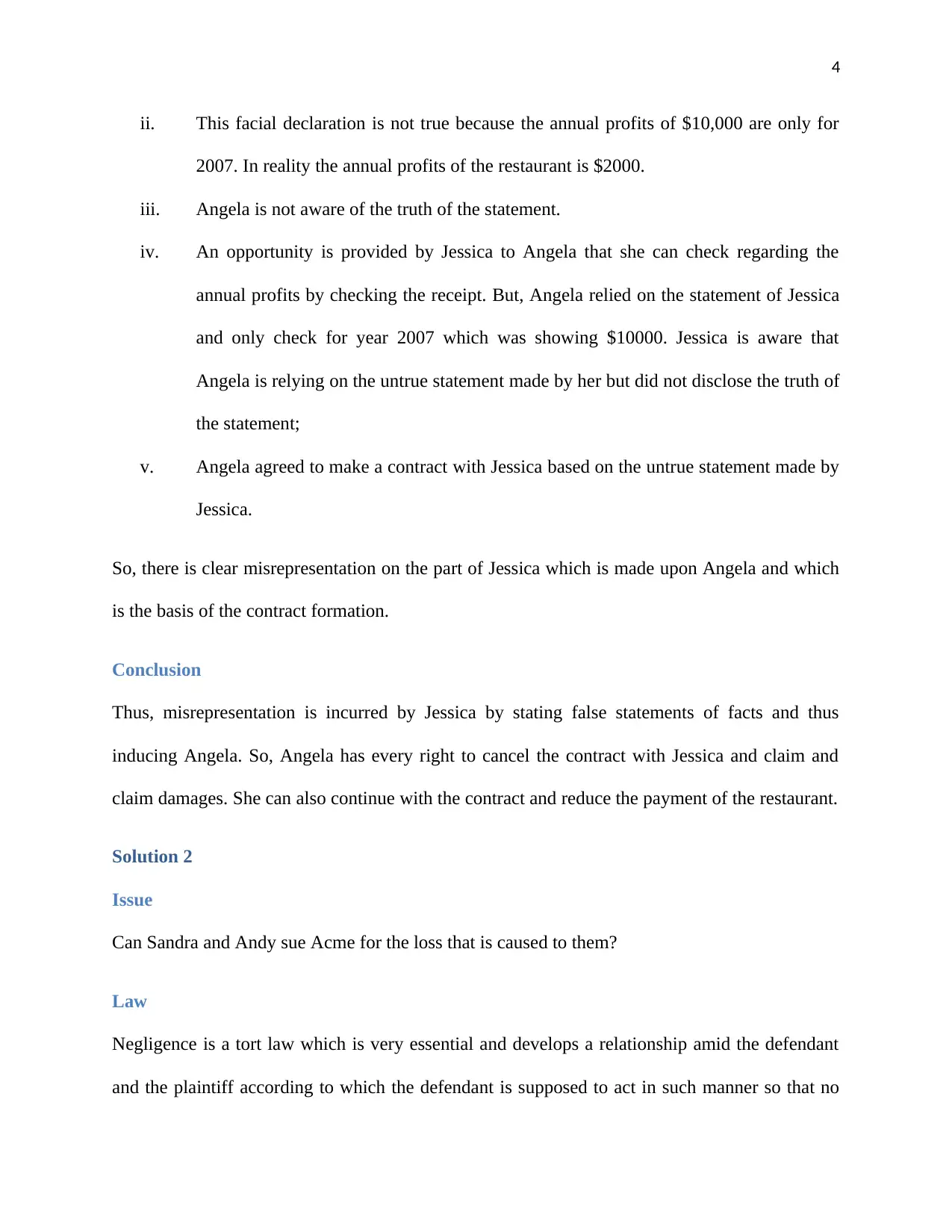
4
ii. This facial declaration is not true because the annual profits of $10,000 are only for
2007. In reality the annual profits of the restaurant is $2000.
iii. Angela is not aware of the truth of the statement.
iv. An opportunity is provided by Jessica to Angela that she can check regarding the
annual profits by checking the receipt. But, Angela relied on the statement of Jessica
and only check for year 2007 which was showing $10000. Jessica is aware that
Angela is relying on the untrue statement made by her but did not disclose the truth of
the statement;
v. Angela agreed to make a contract with Jessica based on the untrue statement made by
Jessica.
So, there is clear misrepresentation on the part of Jessica which is made upon Angela and which
is the basis of the contract formation.
Conclusion
Thus, misrepresentation is incurred by Jessica by stating false statements of facts and thus
inducing Angela. So, Angela has every right to cancel the contract with Jessica and claim and
claim damages. She can also continue with the contract and reduce the payment of the restaurant.
Solution 2
Issue
Can Sandra and Andy sue Acme for the loss that is caused to them?
Law
Negligence is a tort law which is very essential and develops a relationship amid the defendant
and the plaintiff according to which the defendant is supposed to act in such manner so that no
ii. This facial declaration is not true because the annual profits of $10,000 are only for
2007. In reality the annual profits of the restaurant is $2000.
iii. Angela is not aware of the truth of the statement.
iv. An opportunity is provided by Jessica to Angela that she can check regarding the
annual profits by checking the receipt. But, Angela relied on the statement of Jessica
and only check for year 2007 which was showing $10000. Jessica is aware that
Angela is relying on the untrue statement made by her but did not disclose the truth of
the statement;
v. Angela agreed to make a contract with Jessica based on the untrue statement made by
Jessica.
So, there is clear misrepresentation on the part of Jessica which is made upon Angela and which
is the basis of the contract formation.
Conclusion
Thus, misrepresentation is incurred by Jessica by stating false statements of facts and thus
inducing Angela. So, Angela has every right to cancel the contract with Jessica and claim and
claim damages. She can also continue with the contract and reduce the payment of the restaurant.
Solution 2
Issue
Can Sandra and Andy sue Acme for the loss that is caused to them?
Law
Negligence is a tort law which is very essential and develops a relationship amid the defendant
and the plaintiff according to which the defendant is supposed to act in such manner so that no
Paraphrase This Document
Need a fresh take? Get an instant paraphrase of this document with our AI Paraphraser
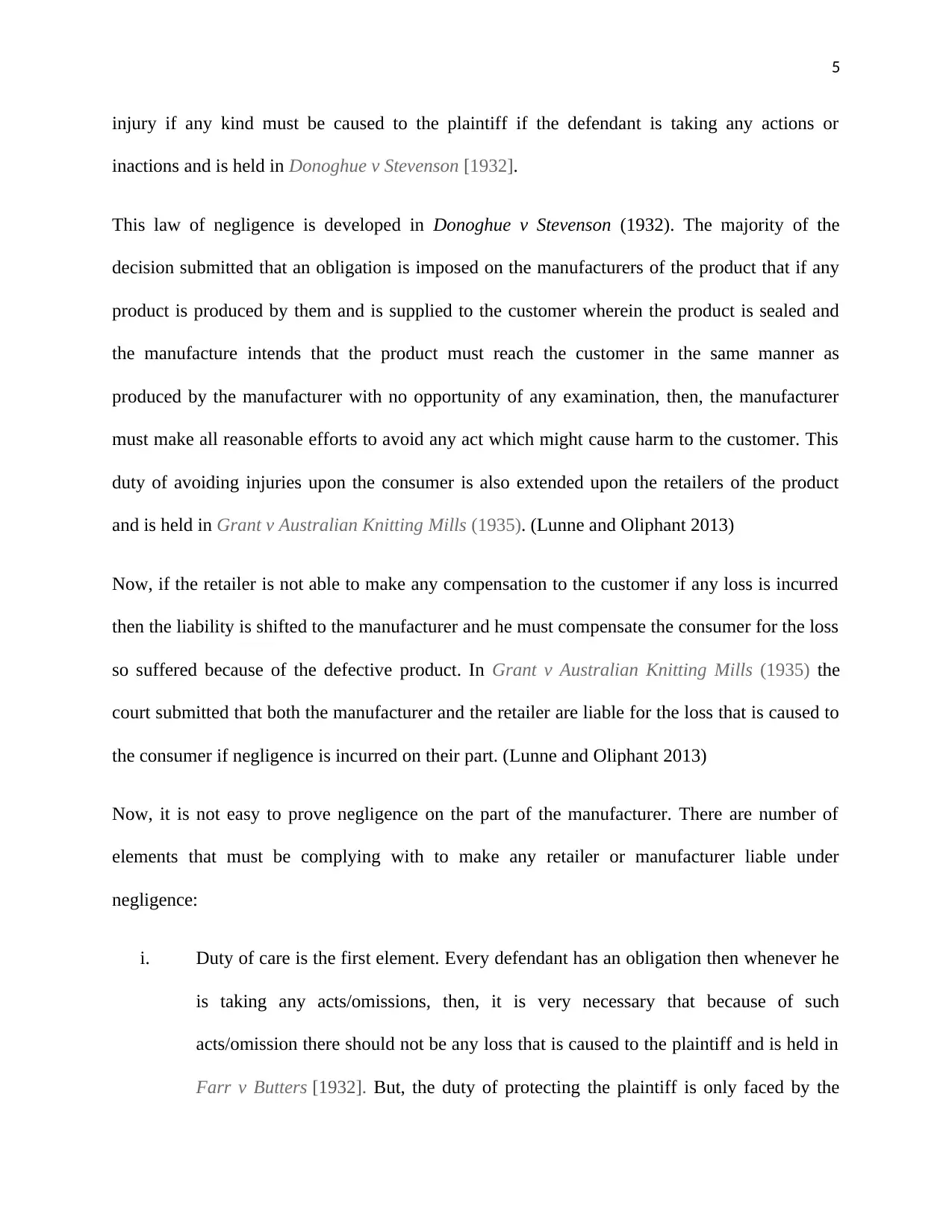
5
injury if any kind must be caused to the plaintiff if the defendant is taking any actions or
inactions and is held in Donoghue v Stevenson [1932].
This law of negligence is developed in Donoghue v Stevenson (1932). The majority of the
decision submitted that an obligation is imposed on the manufacturers of the product that if any
product is produced by them and is supplied to the customer wherein the product is sealed and
the manufacture intends that the product must reach the customer in the same manner as
produced by the manufacturer with no opportunity of any examination, then, the manufacturer
must make all reasonable efforts to avoid any act which might cause harm to the customer. This
duty of avoiding injuries upon the consumer is also extended upon the retailers of the product
and is held in Grant v Australian Knitting Mills (1935). (Lunne and Oliphant 2013)
Now, if the retailer is not able to make any compensation to the customer if any loss is incurred
then the liability is shifted to the manufacturer and he must compensate the consumer for the loss
so suffered because of the defective product. In Grant v Australian Knitting Mills (1935) the
court submitted that both the manufacturer and the retailer are liable for the loss that is caused to
the consumer if negligence is incurred on their part. (Lunne and Oliphant 2013)
Now, it is not easy to prove negligence on the part of the manufacturer. There are number of
elements that must be complying with to make any retailer or manufacturer liable under
negligence:
i. Duty of care is the first element. Every defendant has an obligation then whenever he
is taking any acts/omissions, then, it is very necessary that because of such
acts/omission there should not be any loss that is caused to the plaintiff and is held in
Farr v Butters [1932]. But, the duty of protecting the plaintiff is only faced by the
injury if any kind must be caused to the plaintiff if the defendant is taking any actions or
inactions and is held in Donoghue v Stevenson [1932].
This law of negligence is developed in Donoghue v Stevenson (1932). The majority of the
decision submitted that an obligation is imposed on the manufacturers of the product that if any
product is produced by them and is supplied to the customer wherein the product is sealed and
the manufacture intends that the product must reach the customer in the same manner as
produced by the manufacturer with no opportunity of any examination, then, the manufacturer
must make all reasonable efforts to avoid any act which might cause harm to the customer. This
duty of avoiding injuries upon the consumer is also extended upon the retailers of the product
and is held in Grant v Australian Knitting Mills (1935). (Lunne and Oliphant 2013)
Now, if the retailer is not able to make any compensation to the customer if any loss is incurred
then the liability is shifted to the manufacturer and he must compensate the consumer for the loss
so suffered because of the defective product. In Grant v Australian Knitting Mills (1935) the
court submitted that both the manufacturer and the retailer are liable for the loss that is caused to
the consumer if negligence is incurred on their part. (Lunne and Oliphant 2013)
Now, it is not easy to prove negligence on the part of the manufacturer. There are number of
elements that must be complying with to make any retailer or manufacturer liable under
negligence:
i. Duty of care is the first element. Every defendant has an obligation then whenever he
is taking any acts/omissions, then, it is very necessary that because of such
acts/omission there should not be any loss that is caused to the plaintiff and is held in
Farr v Butters [1932]. But, the duty of protecting the plaintiff is only faced by the
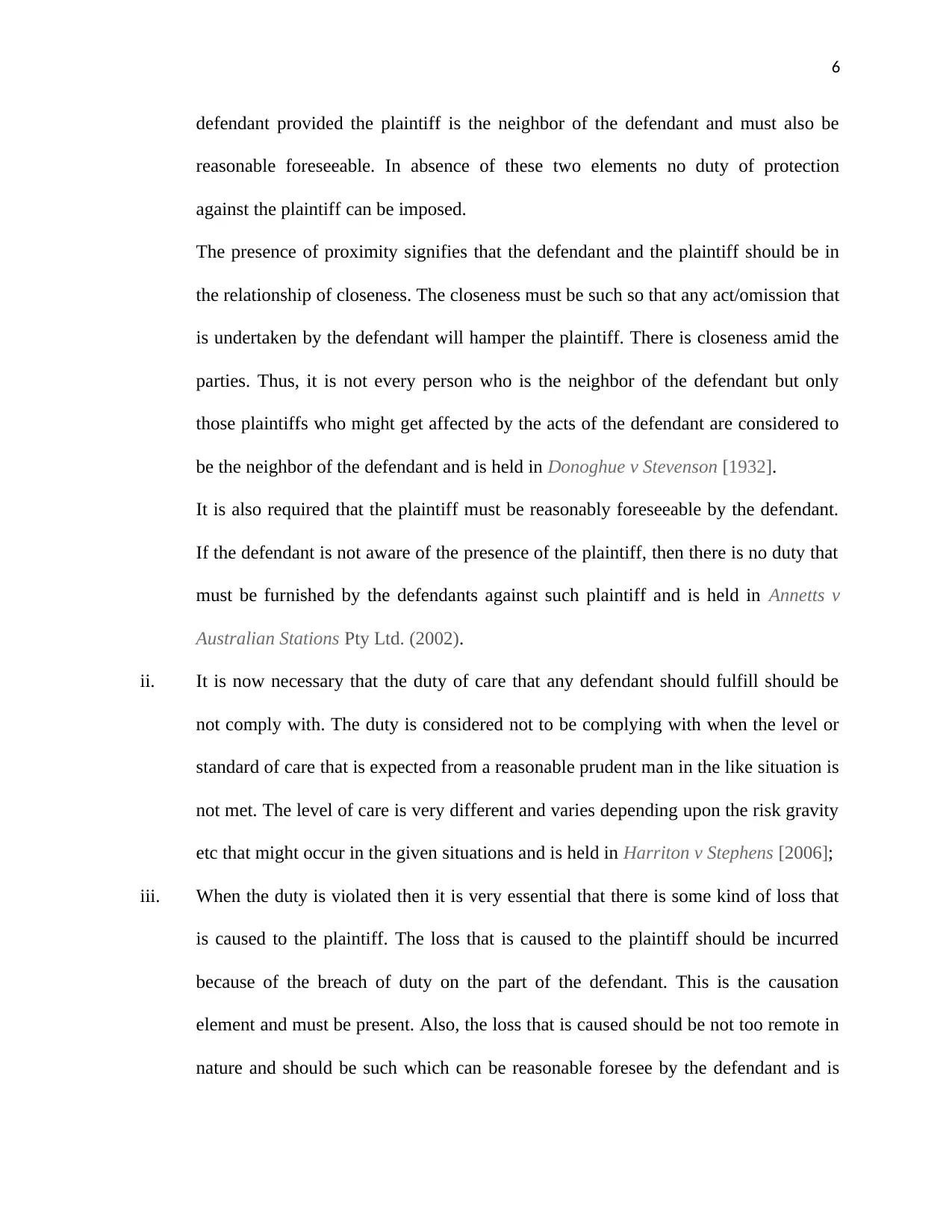
6
defendant provided the plaintiff is the neighbor of the defendant and must also be
reasonable foreseeable. In absence of these two elements no duty of protection
against the plaintiff can be imposed.
The presence of proximity signifies that the defendant and the plaintiff should be in
the relationship of closeness. The closeness must be such so that any act/omission that
is undertaken by the defendant will hamper the plaintiff. There is closeness amid the
parties. Thus, it is not every person who is the neighbor of the defendant but only
those plaintiffs who might get affected by the acts of the defendant are considered to
be the neighbor of the defendant and is held in Donoghue v Stevenson [1932].
It is also required that the plaintiff must be reasonably foreseeable by the defendant.
If the defendant is not aware of the presence of the plaintiff, then there is no duty that
must be furnished by the defendants against such plaintiff and is held in Annetts v
Australian Stations Pty Ltd. (2002).
ii. It is now necessary that the duty of care that any defendant should fulfill should be
not comply with. The duty is considered not to be complying with when the level or
standard of care that is expected from a reasonable prudent man in the like situation is
not met. The level of care is very different and varies depending upon the risk gravity
etc that might occur in the given situations and is held in Harriton v Stephens [2006];
iii. When the duty is violated then it is very essential that there is some kind of loss that
is caused to the plaintiff. The loss that is caused to the plaintiff should be incurred
because of the breach of duty on the part of the defendant. This is the causation
element and must be present. Also, the loss that is caused should be not too remote in
nature and should be such which can be reasonable foresee by the defendant and is
defendant provided the plaintiff is the neighbor of the defendant and must also be
reasonable foreseeable. In absence of these two elements no duty of protection
against the plaintiff can be imposed.
The presence of proximity signifies that the defendant and the plaintiff should be in
the relationship of closeness. The closeness must be such so that any act/omission that
is undertaken by the defendant will hamper the plaintiff. There is closeness amid the
parties. Thus, it is not every person who is the neighbor of the defendant but only
those plaintiffs who might get affected by the acts of the defendant are considered to
be the neighbor of the defendant and is held in Donoghue v Stevenson [1932].
It is also required that the plaintiff must be reasonably foreseeable by the defendant.
If the defendant is not aware of the presence of the plaintiff, then there is no duty that
must be furnished by the defendants against such plaintiff and is held in Annetts v
Australian Stations Pty Ltd. (2002).
ii. It is now necessary that the duty of care that any defendant should fulfill should be
not comply with. The duty is considered not to be complying with when the level or
standard of care that is expected from a reasonable prudent man in the like situation is
not met. The level of care is very different and varies depending upon the risk gravity
etc that might occur in the given situations and is held in Harriton v Stephens [2006];
iii. When the duty is violated then it is very essential that there is some kind of loss that
is caused to the plaintiff. The loss that is caused to the plaintiff should be incurred
because of the breach of duty on the part of the defendant. This is the causation
element and must be present. Also, the loss that is caused should be not too remote in
nature and should be such which can be reasonable foresee by the defendant and is
⊘ This is a preview!⊘
Do you want full access?
Subscribe today to unlock all pages.

Trusted by 1+ million students worldwide
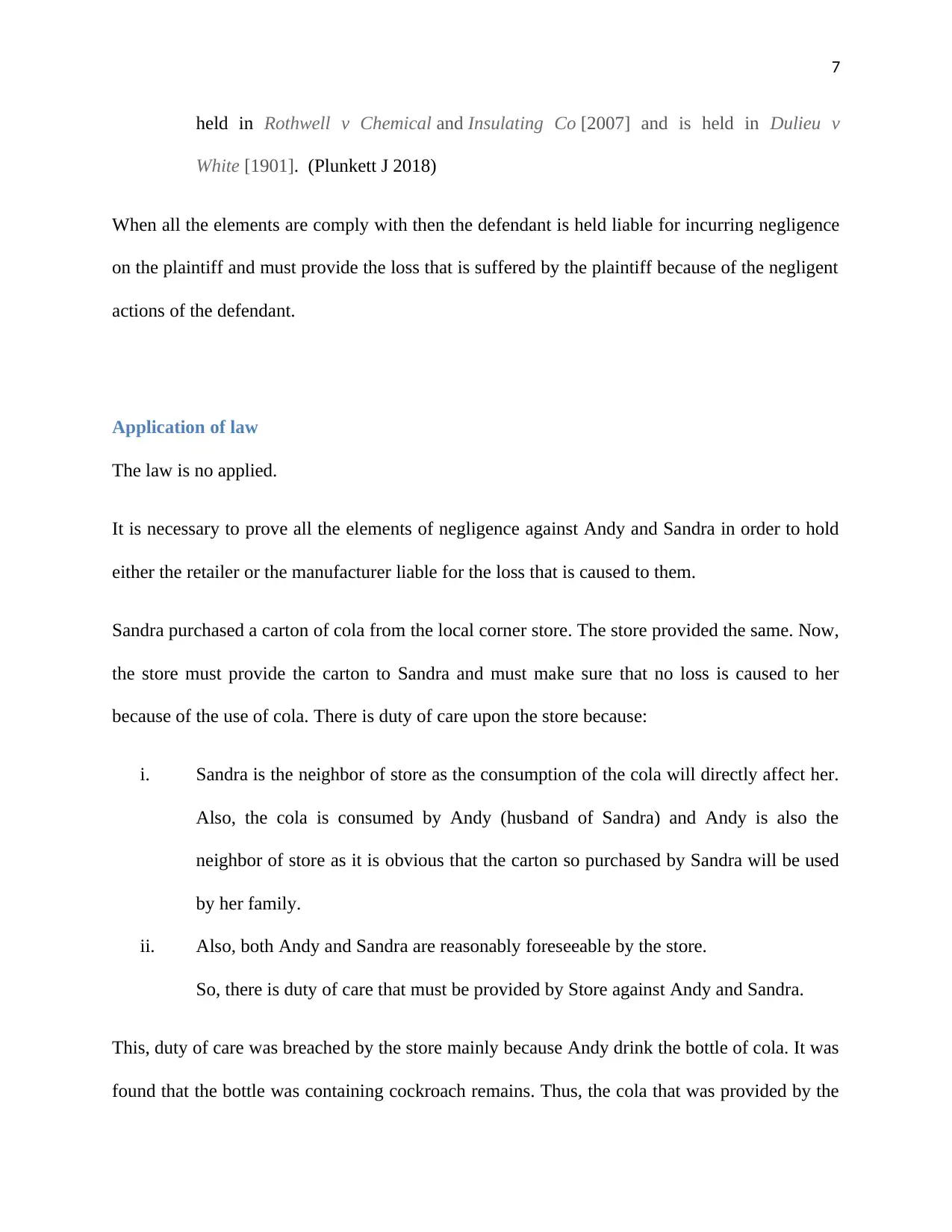
7
held in Rothwell v Chemical and Insulating Co [2007] and is held in Dulieu v
White [1901]. (Plunkett J 2018)
When all the elements are comply with then the defendant is held liable for incurring negligence
on the plaintiff and must provide the loss that is suffered by the plaintiff because of the negligent
actions of the defendant.
Application of law
The law is no applied.
It is necessary to prove all the elements of negligence against Andy and Sandra in order to hold
either the retailer or the manufacturer liable for the loss that is caused to them.
Sandra purchased a carton of cola from the local corner store. The store provided the same. Now,
the store must provide the carton to Sandra and must make sure that no loss is caused to her
because of the use of cola. There is duty of care upon the store because:
i. Sandra is the neighbor of store as the consumption of the cola will directly affect her.
Also, the cola is consumed by Andy (husband of Sandra) and Andy is also the
neighbor of store as it is obvious that the carton so purchased by Sandra will be used
by her family.
ii. Also, both Andy and Sandra are reasonably foreseeable by the store.
So, there is duty of care that must be provided by Store against Andy and Sandra.
This, duty of care was breached by the store mainly because Andy drink the bottle of cola. It was
found that the bottle was containing cockroach remains. Thus, the cola that was provided by the
held in Rothwell v Chemical and Insulating Co [2007] and is held in Dulieu v
White [1901]. (Plunkett J 2018)
When all the elements are comply with then the defendant is held liable for incurring negligence
on the plaintiff and must provide the loss that is suffered by the plaintiff because of the negligent
actions of the defendant.
Application of law
The law is no applied.
It is necessary to prove all the elements of negligence against Andy and Sandra in order to hold
either the retailer or the manufacturer liable for the loss that is caused to them.
Sandra purchased a carton of cola from the local corner store. The store provided the same. Now,
the store must provide the carton to Sandra and must make sure that no loss is caused to her
because of the use of cola. There is duty of care upon the store because:
i. Sandra is the neighbor of store as the consumption of the cola will directly affect her.
Also, the cola is consumed by Andy (husband of Sandra) and Andy is also the
neighbor of store as it is obvious that the carton so purchased by Sandra will be used
by her family.
ii. Also, both Andy and Sandra are reasonably foreseeable by the store.
So, there is duty of care that must be provided by Store against Andy and Sandra.
This, duty of care was breached by the store mainly because Andy drink the bottle of cola. It was
found that the bottle was containing cockroach remains. Thus, the cola that was provided by the
Paraphrase This Document
Need a fresh take? Get an instant paraphrase of this document with our AI Paraphraser
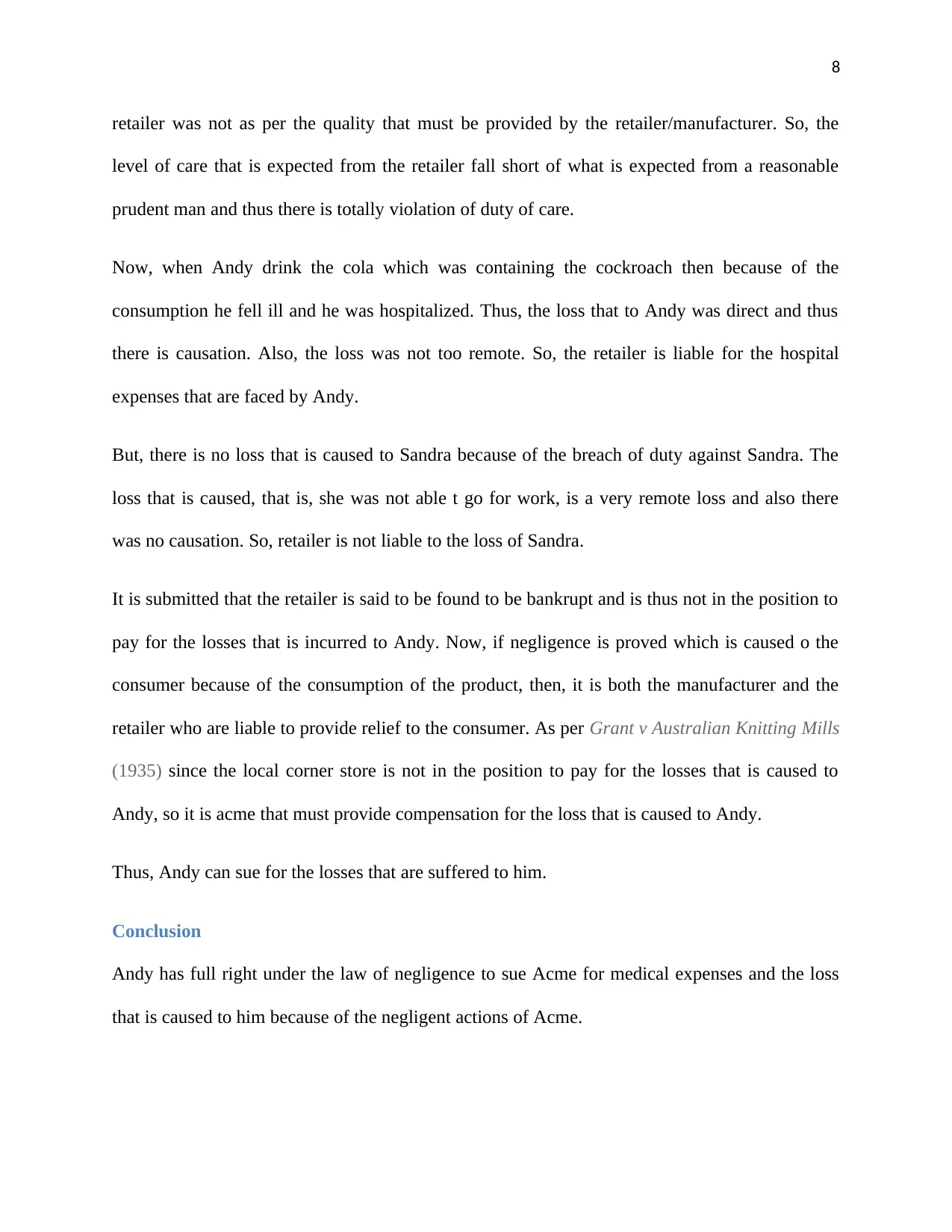
8
retailer was not as per the quality that must be provided by the retailer/manufacturer. So, the
level of care that is expected from the retailer fall short of what is expected from a reasonable
prudent man and thus there is totally violation of duty of care.
Now, when Andy drink the cola which was containing the cockroach then because of the
consumption he fell ill and he was hospitalized. Thus, the loss that to Andy was direct and thus
there is causation. Also, the loss was not too remote. So, the retailer is liable for the hospital
expenses that are faced by Andy.
But, there is no loss that is caused to Sandra because of the breach of duty against Sandra. The
loss that is caused, that is, she was not able t go for work, is a very remote loss and also there
was no causation. So, retailer is not liable to the loss of Sandra.
It is submitted that the retailer is said to be found to be bankrupt and is thus not in the position to
pay for the losses that is incurred to Andy. Now, if negligence is proved which is caused o the
consumer because of the consumption of the product, then, it is both the manufacturer and the
retailer who are liable to provide relief to the consumer. As per Grant v Australian Knitting Mills
(1935) since the local corner store is not in the position to pay for the losses that is caused to
Andy, so it is acme that must provide compensation for the loss that is caused to Andy.
Thus, Andy can sue for the losses that are suffered to him.
Conclusion
Andy has full right under the law of negligence to sue Acme for medical expenses and the loss
that is caused to him because of the negligent actions of Acme.
retailer was not as per the quality that must be provided by the retailer/manufacturer. So, the
level of care that is expected from the retailer fall short of what is expected from a reasonable
prudent man and thus there is totally violation of duty of care.
Now, when Andy drink the cola which was containing the cockroach then because of the
consumption he fell ill and he was hospitalized. Thus, the loss that to Andy was direct and thus
there is causation. Also, the loss was not too remote. So, the retailer is liable for the hospital
expenses that are faced by Andy.
But, there is no loss that is caused to Sandra because of the breach of duty against Sandra. The
loss that is caused, that is, she was not able t go for work, is a very remote loss and also there
was no causation. So, retailer is not liable to the loss of Sandra.
It is submitted that the retailer is said to be found to be bankrupt and is thus not in the position to
pay for the losses that is incurred to Andy. Now, if negligence is proved which is caused o the
consumer because of the consumption of the product, then, it is both the manufacturer and the
retailer who are liable to provide relief to the consumer. As per Grant v Australian Knitting Mills
(1935) since the local corner store is not in the position to pay for the losses that is caused to
Andy, so it is acme that must provide compensation for the loss that is caused to Andy.
Thus, Andy can sue for the losses that are suffered to him.
Conclusion
Andy has full right under the law of negligence to sue Acme for medical expenses and the loss
that is caused to him because of the negligent actions of Acme.
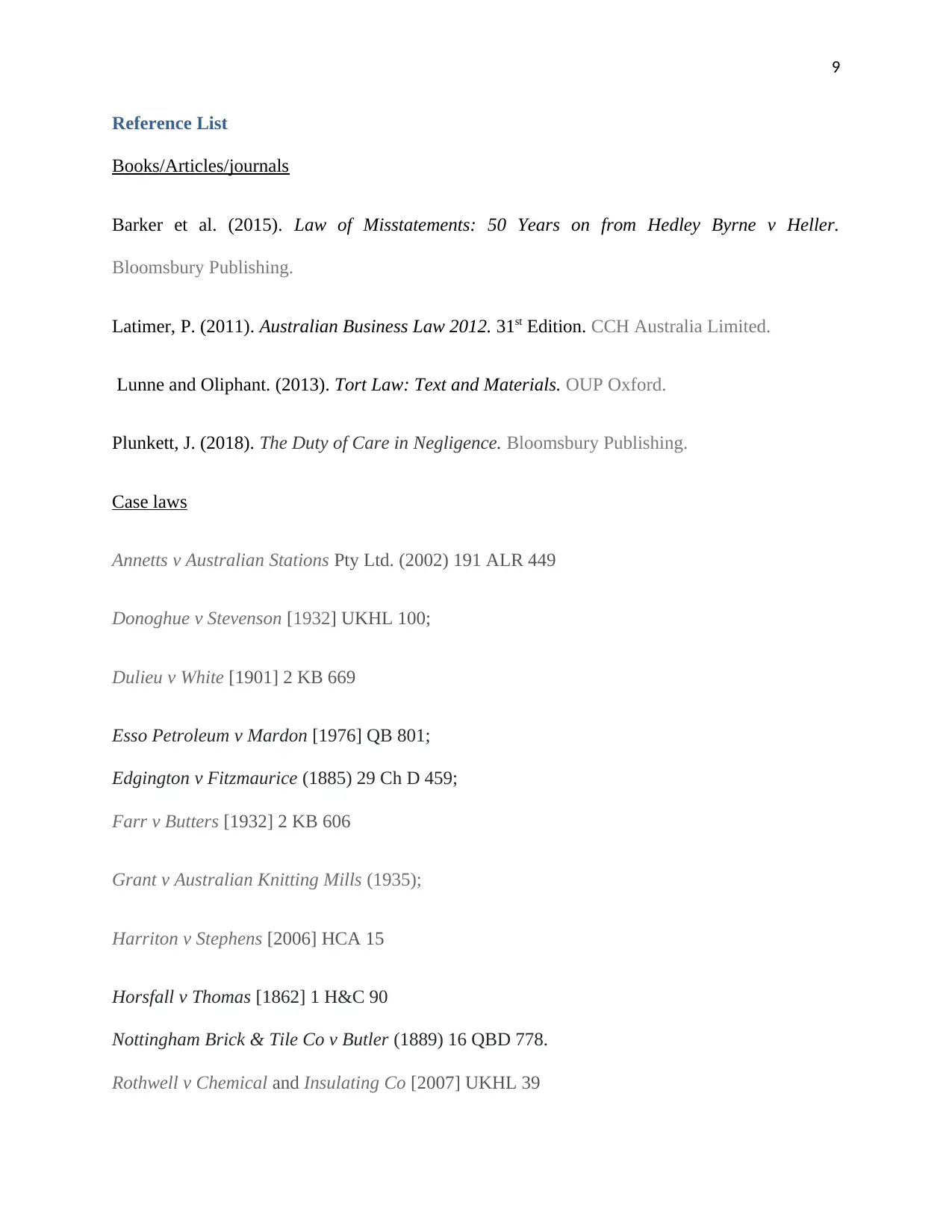
9
Reference List
Books/Articles/journals
Barker et al. (2015). Law of Misstatements: 50 Years on from Hedley Byrne v Heller.
Bloomsbury Publishing.
Latimer, P. (2011). Australian Business Law 2012. 31st Edition. CCH Australia Limited.
Lunne and Oliphant. (2013). Tort Law: Text and Materials. OUP Oxford.
Plunkett, J. (2018). The Duty of Care in Negligence. Bloomsbury Publishing.
Case laws
Annetts v Australian Stations Pty Ltd. (2002) 191 ALR 449
Donoghue v Stevenson [1932] UKHL 100;
Dulieu v White [1901] 2 KB 669
Esso Petroleum v Mardon [1976] QB 801;
Edgington v Fitzmaurice (1885) 29 Ch D 459;
Farr v Butters [1932] 2 KB 606
Grant v Australian Knitting Mills (1935);
Harriton v Stephens [2006] HCA 15
Horsfall v Thomas [1862] 1 H&C 90
Nottingham Brick & Tile Co v Butler (1889) 16 QBD 778.
Rothwell v Chemical and Insulating Co [2007] UKHL 39
Reference List
Books/Articles/journals
Barker et al. (2015). Law of Misstatements: 50 Years on from Hedley Byrne v Heller.
Bloomsbury Publishing.
Latimer, P. (2011). Australian Business Law 2012. 31st Edition. CCH Australia Limited.
Lunne and Oliphant. (2013). Tort Law: Text and Materials. OUP Oxford.
Plunkett, J. (2018). The Duty of Care in Negligence. Bloomsbury Publishing.
Case laws
Annetts v Australian Stations Pty Ltd. (2002) 191 ALR 449
Donoghue v Stevenson [1932] UKHL 100;
Dulieu v White [1901] 2 KB 669
Esso Petroleum v Mardon [1976] QB 801;
Edgington v Fitzmaurice (1885) 29 Ch D 459;
Farr v Butters [1932] 2 KB 606
Grant v Australian Knitting Mills (1935);
Harriton v Stephens [2006] HCA 15
Horsfall v Thomas [1862] 1 H&C 90
Nottingham Brick & Tile Co v Butler (1889) 16 QBD 778.
Rothwell v Chemical and Insulating Co [2007] UKHL 39
⊘ This is a preview!⊘
Do you want full access?
Subscribe today to unlock all pages.

Trusted by 1+ million students worldwide

10
Smith v Hughes (1871) LR 6 QB 597
Smith v Hughes (1871) LR 6 QB 597
1 out of 10
Related Documents
Your All-in-One AI-Powered Toolkit for Academic Success.
+13062052269
info@desklib.com
Available 24*7 on WhatsApp / Email
![[object Object]](/_next/static/media/star-bottom.7253800d.svg)
Unlock your academic potential
Copyright © 2020–2025 A2Z Services. All Rights Reserved. Developed and managed by ZUCOL.





